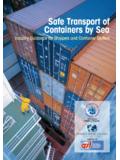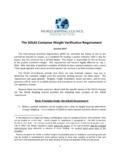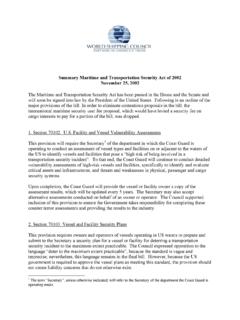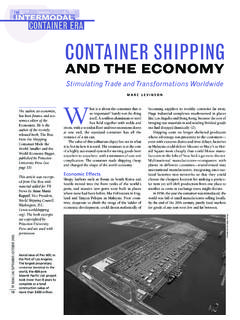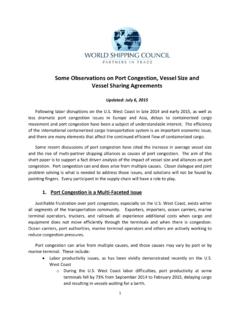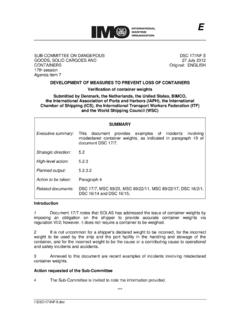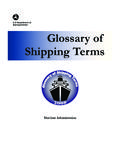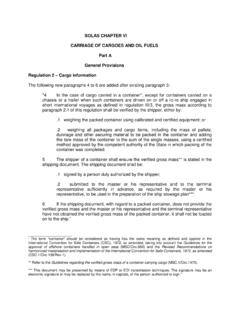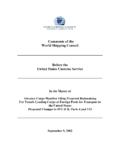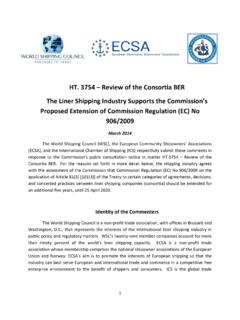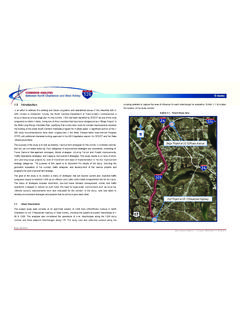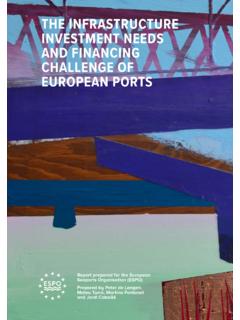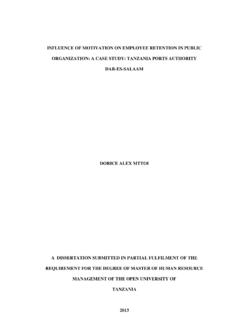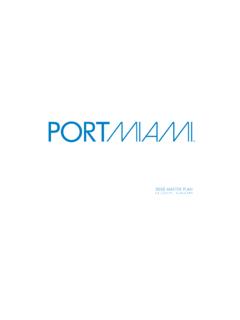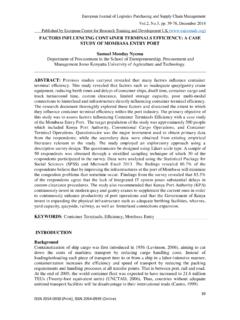Transcription of Valuation of the Liner Shipping Industry
1 1 CO Valuation of the Liner Shipping Industry Economic Contribution and Liner Industry Operations Prepared for: American Automobile Association December 2009 Table of Contents Executive Summary .. 4 What is the Liner Shipping Industry ?.. 4 Key Findings .. 4 Introduction .. 5 Purpose of Report .. 5 Methodology and Data 5 Economic Valuation of the Liner Industry .. 6 Liner Industry Operations and 10 Methodology and Data Sources .. 8 The Liner Fleet .. 9 Fleet Size and 9 14 Vessel Purchase 15 Liner Fleet Operations .. 17 Port Calls and Nautical-Miles 18 Port Expenditures and Operations .. 20 Throughput at Liner 20 Expenditures by Terminal 23 Container 24 Other Liner Industry 25 Summary.
2 26 Appendix A: World Industry Service 27 Data Sources .. 27 Water Transport and Shipbuilding 28 Liner Industry Share .. 28 Definition of WIS Metrics .. 29 Appendix B: Data Sources .. 30 2 Valuation of the Liner Shipping Industry Figures Figure 1: Average Weekly Port Calls Made by Container and Vehicle Vessels, First 35 Weeks of 200918 Figure 2: Average Weekly Nautical-Miles Travelled by Container and Vehicle Vessels, First 35 Weeks of Tables Table 1: Direct Economic Contribution of Shipbuilding and Liner Industry Operations, 7 Table 2: Direct Economic Contribution of Liner Industry Operations, 7 Table 3: Direct Economic Contribution of Shipbuilding, 7 Table 4: Global Liner Fleet, July 9 Table 5: Global Liner Fleet on 10 Table 6: Current and On-Order Liner Fleet by Region, July 11 Table 7: European Union Liner Fleet, July 13 Table 8: Top Twenty Countries by Existing Fleet and Vessels On-Order, July 14 Table 9.
3 Deliveries of Container and Ro-Ro Vessels by Builder Country, 15 Table 10: Cumulative Spending on Liner Vessels by Operating Region through 16 Table 11: Cumulative Receipts from Sales of Liner Vessels by Region of Build as of July, 16 Table 12: Number of Service and Annual Capacity Deployed by Route, as of July 1, 17 Table 13: Average Weekly Number of Port Calls Made by Operator Region in 19 Table 14: Average Weekly Number of Nautical-Miles Travelled by Operator Region in 20 Table 15: Top 20 World Ports by 2008 21 Table 16: Throughput at Select Container Ports in the European Union, 2007- 21 Table 17: Throughput at Select Container Ports in North America, 23 Table 18: Investment by Terminal Operators, 23 Table 19: Container Fleet by Region, 24 Table 20: Container Handling and Trans-shipment, Million TEUs, 25 Table 21: Chassis Fleet and Operating Costs in the United States, 25 3 Valuation of the Liner Shipping Industry Executive Summary Liner Shipping is the service of transporting goods by means of high capacity, oceangoing ships that transit regular routes on fixed schedules.
4 The Liner Shipping Industry is the primary conduit of world trade and an increasingly important part of the maritime Industry . Liner Shipping carries the majority of the world's ocean-borne trade in value terms and facilitates a significant portion of the merchandise trade of the world. The Industry has contributed to advances in the standard of living of most of the world's population in the last 35 years, as the gains from trade through advancing global commerce were enabled by the reliable, efficient and relatively low-cost transportation provided by the Industry . Quantifying the significance of the Liner Shipping Industry can be done using many metrics. Valuable perspectives on the Liner Industry include how much of world trade is handled by the Liner Industry ; the employment, investment, and value added the Industry contributes to the world economy, and the operational characteristics of the Industry in providing services globally.
5 WHAT IS THE Liner Shipping Industry ? The Liner Shipping Industry is the portion of the maritime Industry that includes all operations and related infrastructure involved in scheduled ocean-borne Shipping . It consists of Liner vessels and the people working on-board these vessels, ports, shipbuilding operations, longshore dock workers, shipbuilders, and all other on-shore support staff. Liner shippers transport most of the high unit-value consumer and intermediate goods, including ocean containerized cargo, vehicles, and other mobile machinery. The Industry operates on all oceans and many of the navigable inland waterways world-wide, benefitting consumers and exporters globally. KEY FINDINGS This report provides measures that describe the important role of the Liner Shipping Industry in the world and for key world regions. Among the findings are: The value of the Liner Industry operations and shipbuilding in 2007 is estimated to be $ billion, generating million direct and related jobs.
6 The Liner Industry transported about 60% of the total value of global seaborne trade of US$ trillion in 2007. The Industry has invested in more than 7,000 vessels to provide these services, with approximately another 1,400 on order. Over $235 billion have been spent on new vessels by the Industry . Throughput at the top 20 global ports reached almost 250 million TEU in 2008. In 2008, the global container fleet consisted of million containers, which cost the Industry over $80 billion. In 2009, on average, Liner ships made 10,000 port calls around the world each week. In mid-2007, the Liner Industry operated more than 400 scheduled services serving inter-continental route. 4 Valuation of the Liner Shipping Industry 5 Valuation of the Liner Shipping Industry Introduction The Liner Industry is a crucial segment of the global economy and contributes significantly to world economic output.
7 The Industry is broadly defined as the operations and underlying infrastructure involved in scheduled ocean-borne Shipping . As such, it consists of a variety of components with significant economic impact, including: Liner operating companies Liner vessels Ports of Call Shipbuilding operations Liner Industry operations Liner operating companies generally transport high-value consumer and intermediate goods, including all seaborne containerized cargo, automobiles, and other machinery. As a result, the Industry has a profound effect on consumers and exporters. In 2007, the Industry carried almost 60% of the total value of the world's seaborne commodities on more than 7,000 registered The Industry is especially significant to the economies of the European Union and South Korea in terms of shipbuilding and to the European Union, China, United States, and the Americas in its economic contribution from transport operations.
8 Globally, the Industry was directly or indirectly responsible for over $ billion in output and millions jobs in 2007. PURPOSE OF REPORT This report was commissioned by the World Shipping Council in order to better understand the value and size of the Liner Shipping Industry and its contribution to global trade and national economies. The estimates presented in this report are an initial effort using readily available data from various IHS companies for valuing and sizing the Industry . The majority of the data presented here is from 2007, the most recent year for which economic and trade data is complete. This year also presents the size and impact of the Industry prior to the current global recession and is thus indicative of future operations. METHODOLOGY AND DATA SOURCES The primary information presented in this report is derived from three IHS data sources, described in greater detail in the body of this report: 1.
9 IHS Global Insight World Trade Service (WTS): used to estimate the trade impact of the Liner Industry . 2. IHS Global Insight World Industry Service (WIS): used to estimate the economic and employment impact of the Liner Industry . A detailed explanation of the WIS methodology is available in Appendix B. 1 IHS Lloyd's Register Fairplay fleet database and IHS Global Insight World Trade Service. 3. IHS Lloyd's Register - Fairplay Research (LRF): used for determining the size of the global Liner fleet, its capacity and operating statistics. LRF maintains a comprehensive ongoing registry of all seagoing vessels of 100 gross tons or larger and tracks their operations on an ongoing basis. Where enough geographic detail was available, economic, trade and operating metrics were aggregated by region. The WTS regional trade aggregations are presented in Appendix A.
10 These three databases were supplemented with data obtained from research of websites and annual reports of Liner Industry participants including Liner vessel operators and service providers, ports and port authorities, terminal operators, and equipment manufacturers. Consulting and other research reports were also reviewed. For a full list of reviewed sources please see Appendix C. Economic Valuation of the Liner Industry The most common measures of the value of an Industry in the economy are the value of output produced by the sector and the associated employment provided by this activity. These are commonly measured through the value of the output of the companies in the Industry and the number of workers they employ. This section reviews available economic metrics for the Liner Industry and provides estimates of the economic value of the Liner Industry and its contribution to the global economy and regional economies.
